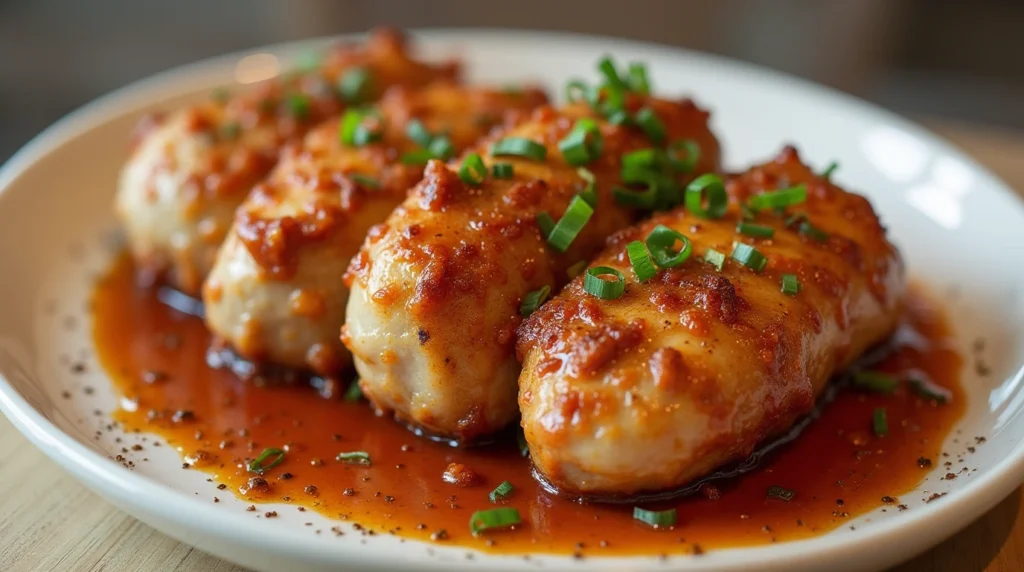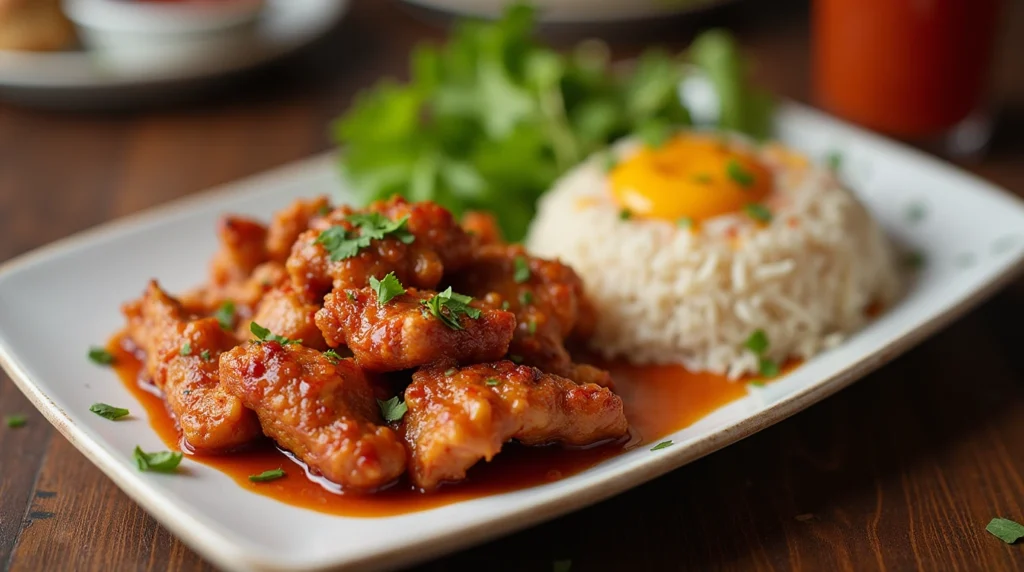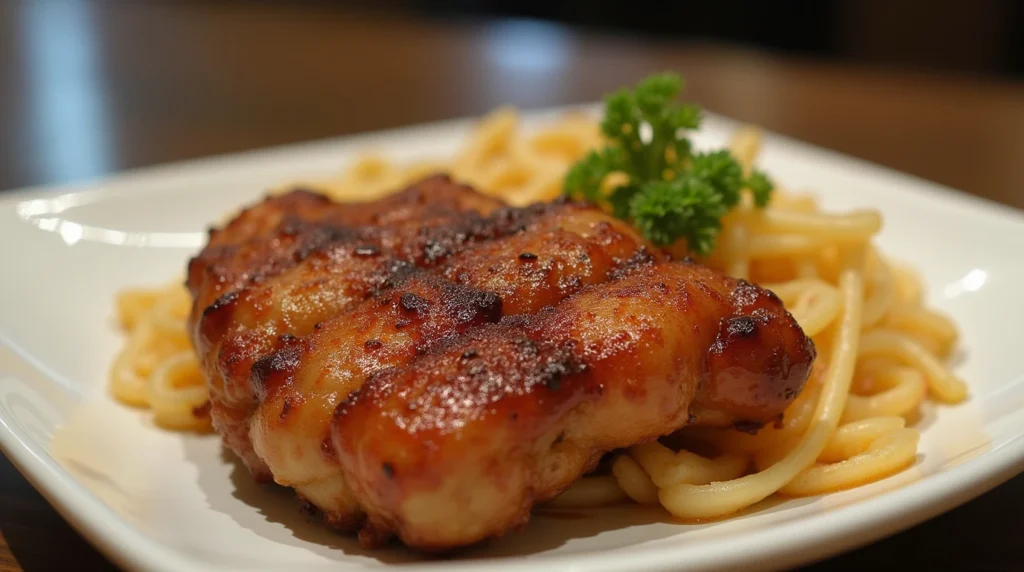Introduction: A Taste of Korea in Your Kitchen

Have you ever craved a dish that’s both comforting and exotic, sweet yet savory, and bursting with flavor? Enter Bulgogi Poulet, a Korean-inspired chicken dish that’s as delightful to make as it is to eat. Imagine tender, juicy chicken marinated in a rich blend of soy sauce, garlic, ginger, and sesame oil, caramelized to perfection. Whether you’re a seasoned home cook or a beginner, this recipe will transport your taste buds to the vibrant streets of Seoul.
In this guide, you’ll learn everything you need to know about making Bulgogi Poulet—from its fascinating origins to step-by-step instructions, tips for perfection, and serving ideas. Let’s dive into this culinary adventure and bring the flavors of Korea to your table!
What is?
The Origins of Bulgogi
- Bulgogi, meaning “fire meat,” is a classic Korean dish traditionally made with thinly sliced beef.
- It dates back to the Goguryeo era (37 BC–668 AD), where it was called “maekjeok” and cooked on skewers.
- Over time, Bulgogi evolved, and modern variations like Bulgogi Poulet (chicken Bulgogi) emerged, offering a lighter, poultry-based alternative.
Why You’ll Love it
- Sweet, savory, and slightly spicy: The marinade creates a perfect balance of flavors.
- Easy to make: With simple ingredients and minimal prep, it’s a weeknight dinner lifesaver.
- Customizable: Adjust the spice level, add veggies, or serve it in creative ways.
Key Ingredients in Bulgogi Poulet
- Essential ingredients: Soy sauce, garlic, ginger, sesame oil, brown sugar, and chicken.
- Optional add-ons: Gochujang (Korean chili paste) for heat, or honey for extra sweetness.
Ingredients You’ll Need for Bulgogi Poulet
Main Ingredients
| Ingredient | Quantity | Purpose |
|---|---|---|
| Chicken (thighs/breast) | 500g | Tender, juicy base for the dish. |
| Soy sauce | ¼ cup | Salty, umami-rich marinade base. |
| Garlic (minced) | 3 cloves | Adds depth and aroma. |
| Ginger (grated) | 1 tbsp | Warm, spicy undertones. |
| Sesame oil | 1 tbsp | Nutty flavor and richness. |
| Brown sugar | 2 tbsp | Balances saltiness with sweetness. |
Flavor Enhancers
- Green onions, sesame seeds, rice vinegar, and gochujang (optional).
Optional Add-ons
- Vegetables like carrots, bell peppers, or onions for a stir-fry twist.
Tools You’ll Need
- Mixing bowl, skillet or grill, measuring spoons, and a sharp knife.
Step-by-Step Guide to Making Bulgogi Poulet
Preparing the Marinade
- In a mixing bowl, combine soy sauce, minced garlic, grated ginger, sesame oil, and brown sugar.
- Add gochujang if you prefer a spicy kick.
- Whisk until the sugar dissolves and the marinade is well-blended.
Marinating the Chicken
- Cut the chicken into thin slices or bite-sized pieces.
- Add the chicken to the marinade, ensuring each piece is well-coated.
- Cover and refrigerate for at least 30 minutes (or up to 24 hours for deeper flavor).
Cooking the Bulgogi Poulet
- Heat a skillet or grill over medium-high heat.
- Add the marinated chicken, cooking for 5-7 minutes per side until caramelized and cooked through.
- Avoid overcrowding the pan to ensure even cooking.
Serving Suggestions
- Serve with steamed rice, kimchi, or lettuce wraps for a low-carb option.
- Garnish with sesame seeds and chopped green onions for a finishing touch.

Tips for Perfect Bulgogi Poulet
Choosing the Right Chicken
- Chicken thighs: Juicier and more flavorful than breasts.
- Chicken breasts: Leaner option for a healthier twist.
Adjusting the Flavor
- Sweeter: Add honey or extra brown sugar.
- Spicier: Increase the amount of gochujang.
- Tangier: Add a splash of rice vinegar.
Meal Prep and Storage
- Storage: Keep in an airtight container for up to 3 days.
- Freezing: Freeze the marinade or cooked chicken for up to 2 months.
Common Mistakes to Avoid
- Overcooking: Keep an eye on the chicken to prevent dryness.
- Skipping the marinade: Patience is key for maximum flavor.
Why Bulgogi Poulet is a Must-Try Dish
A Fusion of Flavors
- Combines the bold flavors of Korean cuisine with the versatility of chicken.
Healthy and Versatile
- High in protein, low in carbs, and customizable to suit dietary preferences.
Perfect for Any Occasion
- Ideal for weeknight dinners, meal prep, or impressing guests at a dinner party.
Explore More Korean Recipes
- Expand your culinary horizons with dishes like Bibimbap, Japchae, or Tteokbokki.
The Cultural Significance of Bulgogi in Korean Cuisine
Bulgogi as a Symbol of Korean Hospitality
- In Korea, Bulgogi is often served during special occasions, family gatherings, and celebrations.
- It’s a dish that symbolizes warmth, generosity, and togetherness.
How Bulgogi Reflects Korean Culinary Philosophy
- Korean cuisine emphasizes balance—sweet, salty, spicy, and umami flavors are harmonized in every bite.
- Bulgogi Poulet embodies this philosophy, offering a perfect blend of flavors and textures.
Modern Adaptations of Bulgogi
- From traditional beef Bulgogi to modern twists like Bulgogi Poulet, the dish has evolved to suit global tastes.
- Fusion dishes like Bulgogi tacos, pizzas, and burgers have also gained popularity worldwide.
Health Benefits of Bulgogi Poulet
High-Protein, Low-Carb Meal Option
- Chicken is a lean source of protein, making Bulgogi Poulet a great choice for fitness enthusiasts.
- Pair it with lettuce wraps instead of rice for a low-carb alternative.
Nutrient-Rich Ingredients
- Garlic and ginger: Known for their anti-inflammatory and immune-boosting properties.
- Sesame oil: Rich in healthy fats and antioxidants.
- Gochujang: Contains capsaicin, which may boost metabolism.
Customizable for Dietary Needs
- Gluten-free: Use tamari instead of soy sauce.
- Low-sodium: Opt for reduced-sodium soy sauce.
- Vegan option: Substitute chicken with tofu or mushrooms.

Creative Ways to Serve Bulgogi Poulet
1-Bulgogi Poulet Bowls
- Layer steamed rice, Bulgogi Poulet, and your favorite veggies (e.g., spinach, carrots, cucumbers).
- Drizzle with extra marinade or a spicy mayo sauce.
2-Bulgogi Poulet Lettuce Wraps
- Use large lettuce leaves as a low-carb wrap.
- Add a spoonful of rice, Bulgogi Poulet, and a sprinkle of sesame seeds.
3-Bulgogi Poulet Tacos
- Fill soft tortillas with Bulgogi Poulet, kimchi, and a dollop of sour cream or yogurt.
- Garnish with cilantro and lime wedges.
4-Bulgogi Poulet Stir-Fry
- Toss the cooked chicken with stir-fried vegetables like bell peppers, onions, and zucchini.
- Serve over noodles or rice for a hearty meal.
Pairing Bulgogi Poulet with Korean Side Dishes (Banchan)
Kimchi
- This fermented cabbage dish adds a tangy, spicy kick to your meal.
Japchae (Glass Noodles)
- Sweet potato noodles stir-fried with vegetables and sesame oil.
Spinach Namul
- Blanched spinach seasoned with garlic, sesame oil, and soy sauce.
Pickled Radishes
- Adds a refreshing, crunchy contrast to the rich flavors of Bulgogi Poulet.
Pro Tips from Korean Chefs
Use Fresh Ingredients
- Fresh garlic, ginger, and green onions make a world of difference in flavor.
Don’t Skip the Sesame Oil
- Toasted sesame oil adds a nutty aroma that’s essential to the dish.
Let the Chicken Rest
- After cooking, let the chicken rest for a few minutes to retain its juices.
Experiment with Marinade Variations
- Add pear or apple puree to the marinade for natural sweetness and tenderness.
Bulgogi Poulet Around the World
Global Popularity of Bulgogi
- Bulgogi has become a beloved dish in many countries, thanks to its irresistible flavors.
- Korean BBQ restaurants worldwide often feature Bulgogi as a signature dish.
Fusion Dishes Inspired by Bulgogi
- Bulgogi burgers, sliders, and even sushi rolls have emerged as creative adaptations.
How to Introduce Bulgogi Poulet to Friends and Family
- Host a Korean-themed dinner night and let everyone customize their Bulgogi Poulet bowls.
The Science Behind the Perfect Bulgogi Poulet Marinade
Why Marinades Work
- Marinades break down proteins, tenderizing the chicken and infusing it with flavor.
- Acidic ingredients (like rice vinegar) and enzymes (from ginger or pear) help soften the meat.
Balancing Flavors in the Marinade
- Sweet: Brown sugar or honey balances the saltiness of soy sauce.
- Salty: Soy sauce provides umami and depth.
- Spicy: Gochujang or red pepper flakes add heat.
- Tangy: Rice vinegar or lime juice brightens the marinade.
The Role of Sesame Oil
- Sesame oil adds a nutty aroma and richness, but it’s best used sparingly to avoid overpowering the dish.
Common Mistakes and How to Fix Them
Overcooking the Chicken
- Problem: Dry, tough chicken.
- Solution: Cook on medium-high heat for 5-7 minutes per side, or until the internal temperature reaches 165°F (74°C).
Skipping the Marinating Step
- Problem: Bland, under-seasoned chicken.
- Solution: Marinate for at least 30 minutes, or up to 24 hours for maximum flavor.
Using Low-Quality Soy Sauce
- Problem: Lack of depth in flavor.
- Solution: Opt for high-quality soy sauce or tamari for a richer taste.
Overcrowding the Pan
- Problem: Steamed instead of caramelized chicken.
- Solution: Cook in batches to ensure even browning.
Bulgogi Poulet for Special Diets
Gluten-Free Bulgogi Poulet
- Substitute soy sauce with tamari or a certified gluten-free soy sauce.
- Ensure all other ingredients (like gochujang) are gluten-free.
Low-Sodium Bulgogi Poulet
- Use reduced-sodium soy sauce and limit added salt.
- Increase the use of garlic, ginger, and sesame oil for flavor.
Keto-Friendly Bulgogi Poulet
- Replace brown sugar with a keto-friendly sweetener like erythritol or monk fruit.
- Serve with cauliflower rice or lettuce wraps instead of regular rice.
Vegan Bulgogi Poulet
- Substitute chicken with tofu, tempeh, or king oyster mushrooms.
- Use the same marinade and cooking method for a plant-based alternative.

The History of Korean BBQ and Its Global Influence
The Rise of Korean BBQ
- Korean BBQ originated during the Goguryeo era and became popular in the 20th century.
- It’s a social dining experience where people grill meat at the table.
How Korean BBQ Conquered the World
- Korean BBQ restaurants have spread globally, from New York to London to Sydney.
- Dishes like Bulgogi and Galbi (grilled short ribs) have become international favorites.
Bulgogi Poulet as a Global Dish
- Bulgogi Poulet represents the adaptability of Korean cuisine to local tastes and ingredients.
- It’s a testament to the universal appeal of sweet, savory, and spicy flavors.
Fun Facts About Bulgogi
Bulgogi in Space
- In 2008, South Korean astronaut Yi So-yeon brought Bulgogi to space, making it the first Korean dish to be eaten in orbit.
Bulgogi’s Role in Korean Pop Culture
- Bulgogi is often featured in Korean dramas and movies, symbolizing comfort and home.
- K-pop stars have shared their love for Bulgogi in interviews and social media.
Bulgogi Festivals
- South Korea hosts annual Bulgogi festivals, celebrating the dish with cooking competitions, tastings, and cultural performances.
How to Host a Korean BBQ Night at Home
Setting the Scene
- Use a tabletop grill or electric skillet for an authentic experience.
- Decorate with Korean-inspired tableware and lanterns.
Menu Ideas
- Main Dishes: Bulgogi Poulet, Samgyeopsal (pork belly), and Galbi (beef short ribs).
- Side Dishes: Kimchi, Japchae, and various namul (seasoned vegetables).
- Desserts: Bingsu (shaved ice) or yakgwa (honey cookies).
Drinks to Serve
- Soju, makgeolli (rice wine), or Korean beer.
- Non-alcoholic options like sikhye (sweet rice drink) or barley tea.
Tips for a Successful BBQ Night
- Prep ingredients in advance to minimize cooking time.
- Encourage guests to participate in grilling their own meat.
In Popular Culture
Bulgogi in Movies and TV Shows
- Featured in Korean dramas like “Reply 1988” and “Let’s Eat.”
- Often used as a symbol of family bonding and nostalgia.
Bulgogi in Social Media Trends
- #BulgogiChallenge: A viral trend where people share their homemade Bulgogi creations.
- TikTok recipes showcasing quick and easy Bulgogi Poulet hacks.
Celebrity Endorsements
- K-pop idols like BTS and BLACKPINK have shared their love for Bulgogi in interviews.
- Celebrity chefs like Maangchi have popularized Bulgogi recipes online.
Conclusion: Bring Korea to Your Table
Making Bulgogi Poulet is more than just cooking—it’s an experience that brings people together through food. With its irresistible flavors and simple preparation, this dish is sure to become a staple in your kitchen. So, grab your ingredients, fire up the stove, and let the aroma of garlic, ginger, and sesame oil fill your home.
Don’t forget to share your Bulgogi Poulet creations with us in the comments below! What’s your favorite Korean dish? Let’s keep the conversation going.
FAQ Section
Q1: What does Bulgogi Poulet taste like?
A: Bulgogi Poulet is a harmonious blend of sweet, savory, and slightly spicy flavors, with a hint of nuttiness from sesame oil.
Q2: Can I use beef instead of chicken for Bulgogi?
A: Absolutely! Traditional Bulgogi is made with beef, but chicken offers a lighter, equally delicious alternative.
Q3: How long should I marinate the chicken?
A: For best results, marinate the chicken for at least 30 minutes, or up to 24 hours for deeper flavor.
Q4: Is Bulgogi Poulet gluten-free?
A: Use tamari or a gluten-free soy sauce to make this dish gluten-free.
Q5: Can I make Bulgogi Poulet ahead of time?
A: Yes! You can marinate the chicken overnight or freeze the cooked dish for later use.
So, what are you waiting for? Gather your ingredients, follow the steps, and let the magic of Bulgogi Poulet transform your kitchen into a Korean BBQ haven. Don’t forget to share your creations with us in the comments below. What’s your favorite way to enjoy Bulgogi Poulet? Let’s keep the conversation going!
